UPDATE: 14th Feb, 4pm: Yuya’s heart scarab & shabti found on museum grounds; at least 8 amulets stolen from Dashur; Egyptian antiquities workers protesting
UPDATE: 15th Feb, 11:20pm: Zahi Hawass says they have found part of the statue of Tutankhamun being carried by a goddess; a statement from UNESCO; other updates from Dr. Hawass & the Egyptian Museum
UPDATE: 17th Feb, 11:40am: the statue of Akhenaten has been found in Tahrir Square rubbish; a statement from Zahi Hawass clarifying earlier statements
UPDATE: 17th Feb, 1pm: SCA Press Release states false doors stolen from tombs in Saqqara & Abusir and magazines broken into, but other looting attempts thwarted
UPDATE: 18th Feb, 10:45am: Blue Shield report says Memphis Museum not looted, confirms a number of tombs safe; latest update from Dr. Hawass shows Akhenaten statue being returned; videos from inside the Egyptian museum
The nation of Egypt has now embarked on a brave new beginning, achieved through passionate but peaceful demonstrations by people throughout the country. However, amidst scenes of celebration in Tahrir Square, sad news has emerged from the museum that is situated there. The Minister of Antiquities Dr. Zahi Hawass has now released the news that there have indeed been a number of objects stolen from the museum and that De Morgan’s magazine at Dashur has also been looted.
So far, this is the list of stolen objects that has been released (I will add to the photographic record as I am able to):
1. Gilded wood statue of Tutankhamun being carried by a goddess
2. Gilded wood statue of Tutankhamun harpooning. Only the torso and upper limbs of the king are missing
3. Limestone statue of Akhenaten holding an offering table
4. Statue of Nefertiti making offerings
5. Sandstone head of an Amarna princess
6. Stone statuette of a scribe from Amarna
7. Wooden shabti statuettes from Yuya (11 pieces)
8. Heart Scarab of Yuya
It is extremely sad, as these are extraordinary works of art of great historical significance. These particular objects all relate to a particular period of Egyptian history, roughly 1390-1322 BCE, that has particularly resonated with people over the past century. The tomb of Yuya and Thuja was one of the first great discoveries of an almost intact burial, echoed again by the even greater discovery of the tomb of their great-grandson Tutankhamun. Both significantly advanced our understanding of ancient Egypt. Akhenaten’s religious, political, and artistic revolution changed Egypt forever and continues to fascinate and inspire today.
Now we must hope to mobilize the world’s awareness of these objects to be alert to their possible movement or sale. I will try to outline soon some of the current discussion on potential avenues available to thwart the trafficking of stolen Egyptian objects. In recent days, people around the world have been inspired by the spirit of the Egyptian people. No one can now doubt that they are capable of great achievements now, in the past, and in the future. Insha’Allah, the stolen objects will be recovered soon, but until then, people around the world who love Egypt will surely be willing to offer whatever help they can.
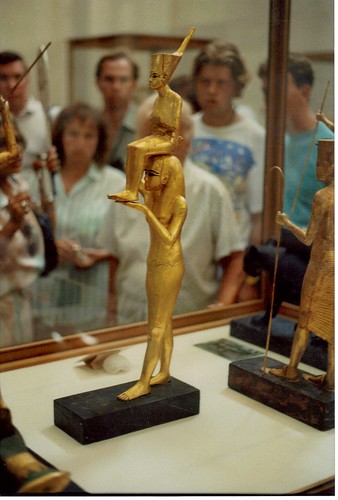
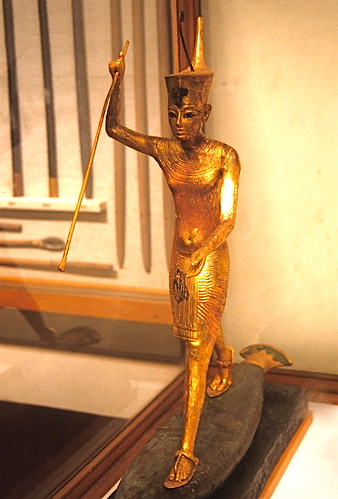
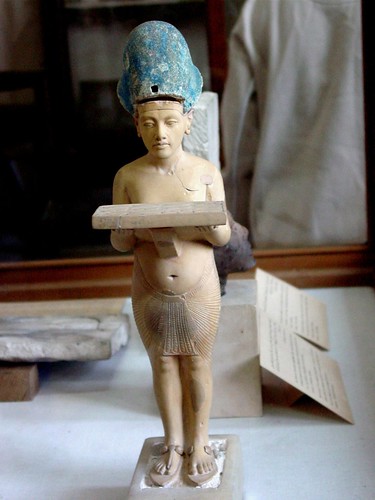
4. Statue of Nefertiti making offerings, not identified yet
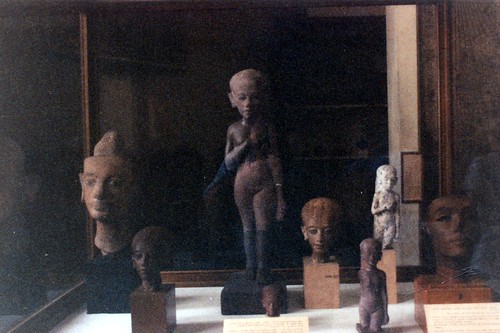
Many of the Amarna princess heads are carved in quartzite. There is at least one in red sandstone though, Cairo JE 44871. There is supposedly a photo of it in Borchardt, Ludwig, Ausgrabungen in Tell el Amarna 1912/13, in: Mitteilungen der Deutschen Orient-Gesellschaft 52, 1913, pl. 21. I don’t have library access today, but will get look it up tomorrow, unless anyone else can get a hold of it.

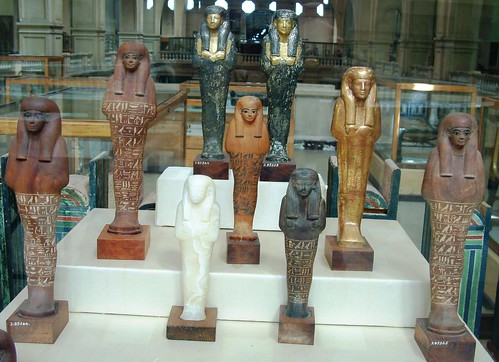
The original publications of the objects from the tomb of Yuya and Tujya seem a bit unclear about Yuya’s heart scarab. A number of scarabs have the name of Tujya inscribed on them and none seem to be mentioned with Yuya’s name. An unattributed scarab from the tomb, Cairo CG 51165, is described in James Quibell’s The Tomb of Yuaa and Thuiu, Catalogue Général du Musée du Caire 51001-51191 (Cairo: IFAO, 1908). The scarab is described thus on page 61 and a photograph is provided, reproduced below, on plate 49:
“51165. Scarab. Green feldspar. Length 0m 114mill. (pl. XLIX).
Scarab of green stone decorated with gold; the base plate is longer than the scarab itself and is carved to represent a heart. The end was pierced for suspension and is broken. There is a second hole through the middle of the plate. On the base is an incised inscription of thirteen lines containing the Heart Chapter (xxxb).
BIBL. : Th. Davis, Tomb of Iouiya, p. 33, pl. XLIII.â€
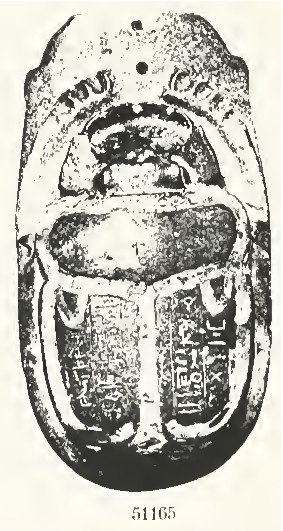
The entry for this scarab is linked in the bibliography to what seems to be a completely different scarab in Theodore Davis’ The Tomb of Iouiya and Touiyou (London, 1907), a scarab is depicted in the painting reproduced here in plate 43 and described on page 33 as: “Scarab-amulet in green beryl with head chipped, and inscribed with the chapter of the Heart from the Book of the Head. It bears the name of Touiyou.”
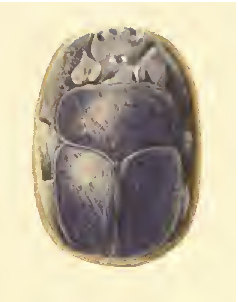
The first scarab seems the much more likely candidate, but I’m still not sure, and I hope that we can clarify this soon. If anyone has suggestions or comments about the identification of these objects, please comment below or email me!
It is still not known what was taken from Dashur. There was previously a report from Nicole Kehrer of the German Archaeological Institute in Berlin saying their storage facility was broken into and looted and it sounds like the De Morgan magazine may be different from this.
It is odd that the Akhenaten sculpture was initially announced as being damaged and the Tutankhamun harpooning statue was only briefly mentioned, but both are now known to be stolen. Is it just a coincidence that all of the objects announced as stolen are very famous? Were no other less well-known objects taken? It is possible that there may be more sad news in days to come.
UPDATE: 14th Feb, 4pm:
In a strange but welcome turn of events, Dr. Zahi Hawass announced that Yuya’s heart scarab and one of the shabtis has been found in the grounds of the museum, just a day after the announcement of the theft, which occurred over two weeks ago. The report also states that Dahshur was looted for the second time on Sunday.
It was also announced in Ahram Online that an inventory of the recently looted Dashur magazine revealed eight amulets had been stolen. It is not clear whether the inventory is complete or whether this is the full extent of the theft, but that seems doubtful, especially since it has now been targeted twice.
It is also worth noting that there have been various accounts on Twitter, including photos, of protests going on outside the Cairo offices of the Supreme Council of Antiquities, and a new army presence there.
UPDATE: 15th Feb, 11:20pm:
In an interview on CNN, Zahi Hawass stated that in addition to finding Yuya’s heart scarab and one shabti in the grounds of the museum, the goddess section of the statue of Tutankhamun being carried by a goddess has also now been found. However, the figure of Tutankhamun remains missing. The video doesn’t allow embedding, so please click here to view.
UNESCO has released a statement from their Director-General Irina Bokova calling for increased vigilance from national and international authorities, art dealers and collectors following the reports of thefts from the Egyptian Museum in Cairo and other sites throughout the country.
CBS also featured an interview with Dr. Hawass downplaying the thefts from the museum:
According to Nigel J. Hetherington on the Facebook group Restore + Save the Egyptian Museum, Dr. Hawass made this statement in response to the recent protests at the headquarters of the Supreme Council of Antiquities in Cairo:
In light of recent events, I have been meeting with the heads of the sectors of the Ministry of Antiquities with a view to addressing and solving the issues raised by those who have voiced concern outside our building in Zamalek. We want to work with these young people to satisfy their demands, and work out the best way to do so. An announcement will be made on Wednesday concerning this.
Yasmin El Shazly, who works at the Egyptian Museum, posted this statement to the Restore + Save Facebook group, asking for patience with the museum and their ongoing work:
As someone who works for the Egyptian Museum, I have been resisting the urge to respond to all your concerns, since we are still in the process of assessing the damage that happened. All I can say is that you have to understand that we just had a revolution. Most staff members had very limited access to the museum until very recently, since the museum was under the responsibility of the army. It is a very difficult time for all of us, and you cannot imagine the amount of stress we are under. Dr. Zahi was appointed minister in a very critical time. We ask for your patience and cooperation and I assure you that Dr. Zahi Hawass and Dr. Tarek El Awady will provide all the information you want in due time.
UPDATE: 17th Feb, 11:40am:
The New York Times (via Kate) has two articles reporting that the beautiful limestone statue of Akhentaten holding an offering table was found in the rubbish near Tahrir Square by a boy whose uncle was a professor at the University of Cairo. The condition of the statue is not mentioned, but it is a huge relief that it has been found, especially when it could quite easily have been lost amongst the discarded rubbish. Dr. Hawass says: “We are going to look inside all the garbage that they collected from Tahrir Square to find the rest of the objects.â€
Dr. Zahi Hawass also released a statement yesterday clarifying the current situation and earlier statements made on his blog. There are also photos of the Tutankhamun panther statue in its damaged state and after its restoration had begun.
UPDATE: 17th Feb, 1pm:
According to Ahram Online, “Sabry Abdel Aziz, head of the Pharaonic Sector of the Ministry of State for Antiquities Affairs, reported on Thursday that the tomb of Hetep-Ka, in Saqqara, was broken into, and the false door was stolen along with objects stored in the tomb. In Abusir, a portion of the false door was stolen from the tomb of Re-Hotep. In addition, many magazines also suffered break-ins: magazines in Saqqara, including the one near the pyramid of Teti, and the magazine of Cairo University all had their seals broken. In an attempt to compile full reports of what is missing, a committee to determine what, if anything, is missing from these magazines has been established”. Further looting was prevented in Tell el Basta and a tomb in Lisht, but “there have also been many reports of violations of archaeological sites in the form of the illegal building of houses and digging.”
According to Rossella Lorenzi, a journalist for the Discovery Channel, the SCA press release also stated that all “Pharaonic, Coptic, Islamic, and modern sites would reopen to the public on Sunday, 20 February 2011.”
Here is an image of the false door of Rahotep from Abusir, from which a section has been stolen, illustration from Miroslav Barta’s article ‘The Title Inspector of the Palace during the Egyptian Old Kingdom’ in Archiv Orientalni 67 (1999), 1-20:
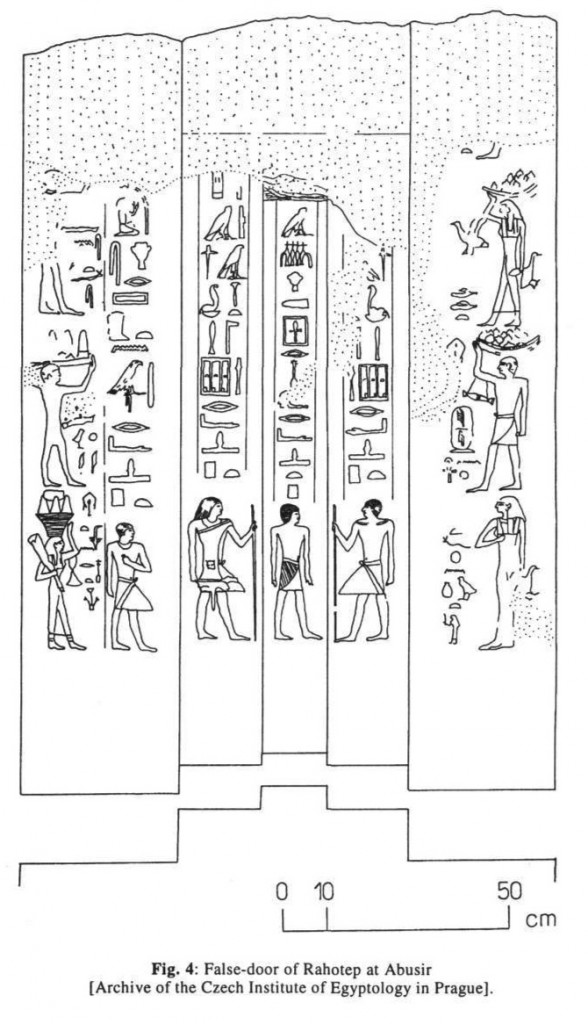
UPDATE: 18th Feb, 10:45am:
Kate at KV64 has posted a Blue Shield report from a number of the sites that had been reported as looted and the news seems fairly positive. I have not had a chance yet to review the report fully or their collection of site photos and would welcome anyone who wants to comment on them. Kate says:
In summary the museum at Memphis has not been looted as previously reported. As suspected, there was widespread digging at Abusir but it was shallow and is not believed to have disturbed the archaeology. The news from Dashur and Saqqara is less good and there has been forced entry into tombs and looting of magazines. The very good news is that tombs and reliefs show no sign of damage, although today’s report from the SCA show that some items stored within tombs were taken. It wasn’t possible to enter every tomb: this was a flying visit and some tombs are bricked up for their protection. As I have said before, over the next few months these will need checking. Nonetheless that tombs which were inspected were undamaged is highly encouraging. That includes the unique Pyramid Texts in the Unas Pyramid which very surprisingly wasn’t even entered by the looters.
Zahi Hawass’ latest blog update shows the Akhenaten statue being returned relatively undamaged, the offering tray having been broken off but found within the museum.
Dr. Hawass also confirms the Ministry of Antiquities statements about looting: “At Saqqara, the tomb of Hetepka was broken into, and the false door may have been stolen along with objects stored in the tomb. I have arranged for a committee to visit the tomb this coming Saturday to compare the alleged damage with earlier expedition photos. In Abusir, a portion of the false door was stolen from the tomb of Rahotep. In addition, break-ins have been confirmed at a number of storage magazines: these include ones in Saqqara, including one near the pyramid of Teti, and the magazine of Cairo University. I have created a committee to prepare reports to determine what, if anything, is missing from these magazines.”
A video from the French press agency AFP shows the Mesehti model boat and Nubian soldiers (at the 1:32 mark) and the cartonnage of Tujya (at mark 1:44) have been restored and are already back on display.
Other videos put online after journalists were given a tour of the museum include a BBC video report from inside the museum and a Russian news video showing footage from the museum.
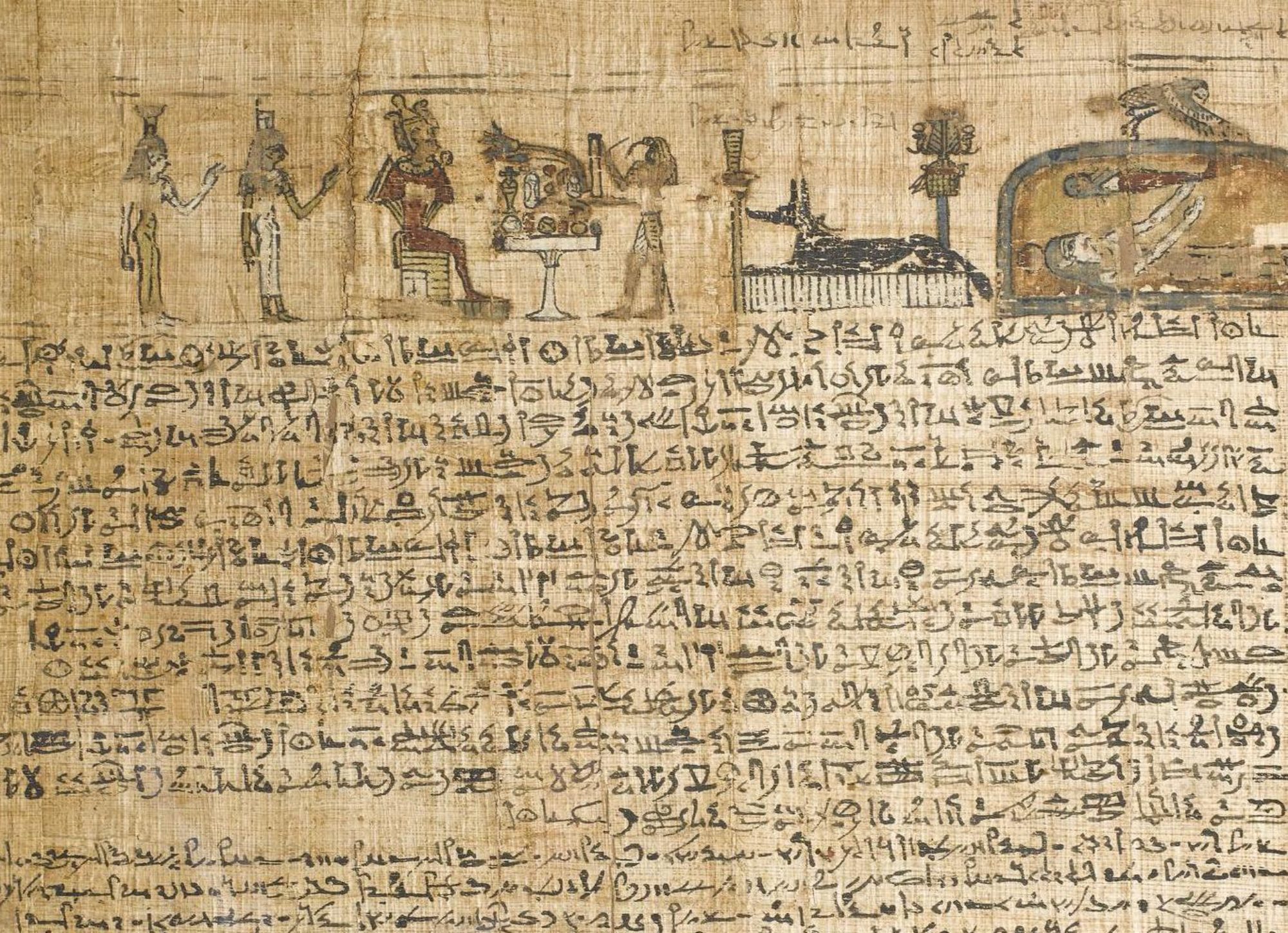
The tragedy isn’t just the losses. We had two substantially complete tombs from the Valley of the Kings: we have lost items from not just one of these, but both.
Very sad to hear the magazine at Dahshur was looted last night.
After all that has happened it seems the pyramid fields are still not being properly protected to prevent further theft and damage.
This is terrible news.
This kind of news terrifies me! Why didn’t the army ensure the museum was not robbed! And what happened to the security system!
I wonder who prepared these theiths that was made , they knew what to steel. and at waht time . and where the items were exactely > this is an inside robery . my heart breaks for what we are going through for all these years , Egypt was not robed only that night , but for years
I agree, it must have been an inside(r) job. It seems ironic to lose items from Tut who was a revolutionary in his own time. Surely these priceless treasures will surface, all we can do is spread the word in hope that recognition will bring their return. Sad that Egypt was looted by Mubarak for so much money…now someone has looted Egypts history. We can only hope that the thefts were done for monetary purposes as their going on the market often brings such objects home. It reminds me that there are people being held captive still in Egypt, heartbreaking to consider her history & past are being held captive now as well. Hopefully when the revolutionaries demands of freedom for all prisoners are met, these items return home as well. So heartbreaking.
Margaret,
Do we know which of the two harpoon statues was stolen?
Kate
That’s very sad… Hope they can find these treasures.
Greetings from Morocco
It feels like art theft ‘to order’, as they specifically targeted Amarna objects, but is that so? What puzzles me, is the nature of the pieces. There were far nicer Amarna objects around than the ones they picked! Just imagine, what would you have picked if you had a choice to order such a theft, or if you yourself were there to do it on the spot? The limestone statue of Akhenaten holding an offering table would not have been my choice, just for its weight alone. Or that Yuya (?) heart scarab… The Tutankhamen gilded statues, though not big, are difficult to transport and hide, while other maybe even nicer and smaller gilded pieces from the same tomb would have been available. A queer selection, indeed. Looks rather random in hindsight. This ‘theft’ thing doesn’t feel right. I strongly wonder if there is maybe other motive behind it.
Very sad indeed ….
Hope that they will soon return to Egypt.
Hans – I’m with you in much of what you say. The Amarna connection is obvious – but why? It was dark in there; whomever took the objects might have mistaken them for others they were aiming for. And, these artifacts simply cannot be sold without great difficulty. It seems to me that it was obviously an “inside” job of sorts; by whom exactly, I don’t know. It might be the guys in charge of this poorly-thought out heist sent one or more guys down there to get specific things – with descriptions – but the actual robbers weren’t educated enough in Amarna art to get it right. Or, they got it right. All speculation. But, there seems to be many things going on here – other motives as Hans put it – that hopefully will come out.
It is incredible that Dahshur is still not under guard.
News today adds that De-Morgans storage magazine has now been looted a second time in two days.
Obviously, all is NOT safe and secure as Hawass is repeatedly stating.
I became alarmed when the Hawas directives from the start sought to give blanket reassurances that all was well with artifacts ALL OVER Egypt. Alarm bells rang. Especially at the beginning of the turmoil. How could these assurances be given so confidently without recourse to communications and on-site checking at the different locations? The unprofessional attempts to assert unproven impositions that ‘all is well’ only succeeded in revealing panic and setting off alarm bells.
Why have so many sites and museums in Egypt been so criminally and woefully inadequately guarded? To hear that there may have been no insurance attached to the museums is further alarming. Apart from the obvious, insurance premiums means that there are continual checks and balances for each and every object. Insurance thus acts as deterrent from internal theft. Mr Hawas has indeed a lot to answer for in his overall guardianship of his country’s and these world sites.
This seems to me to be an inside job, pick up a few very expensive items which could be hidden easily, smuggled out easily and sold illegally to whoever is the willing buyer. I hope Interpol and Art Dealers collaborate and nab the thieves and their helpers.
It was heartening to see a number of the non violent protesters link their arms up and form a human chain to guard the Egyptian MUseum after news broke out about the first thefts. Imagine how much worse things would have been if that had not been done.
I have a sad heart for what has happened.
So much history may be lost forever.
Dr.Hawass, I’m as mad as you,
Respectfully,
Terri
I can’t believe that this artifacts was stolen, I’m too Sad for all
B.
I remember seeing the Treasures of Tutankhamun at the British Musuem in 1972 seeing the gilded wooden figure of Tutankhamun harpooning – striking majestic stance – wonderful peice of ancient Egyptian Art from that period surpassing anything else – shameful that this was taken – every effort should be made to recover this artifact – it was said that 2 uniformed police officers were responsible for the theft at the Cairo Museum – I pray every effort will insure the recovery of this exceptional piece – please make this a priority – best wishes – Anthony
I sympathize with everyone’s dismay at the thefts and the continued looting of Dashur. I fell in love with the Tutankhamun harpooning statue when I was 6 years old, and the Akhenaten statue is a masterpiece. The thieves must have either known what they were after or were very very lucky. I hope that more of the objects are found and security can be improved immediately- everyone’s contributions here and elsewhere are evidence of the importance the world places on the protection of heritage.
Kate- I’m very sorry I somehow missed your comment asking about the Tut harpooning statues. No I don’t know precisely which one it is, they’re incredibly similar (at least thank goodness the stolen one is not the only one!): http://www.griffith.ox.ac.uk/gri/carter/275e-p0999.html
This is such sad news – I am a little confused though, an earlier statement from Zawi Hawass (around the 6th Feb) had stated a limestone statue of Akhenaten with an offering table had only been damaged, but a similar item now appears to have been stolen.
Does anyone know if there are two examples conforming to this description?
If you look carefully to the pictures of the looting and read the weblog of Zahi Hawass there is something very strange going on. I believe there is evidence that the stone objects stolen from the Amarna showcase 167 where still in the Egyptian Museum by historical Friday February 11.
Sam- I believe they are one and the same (I posted about the identity of statue when it was first discussed as damaged: http://bit.ly/fCrG59).
Huub- yes, according to previously released statements, the Akhenaten statue was supposedly still in the museum, but there may just have been confusion about its whereabouts rather than a second theft. Have you seen pictures to suggest they were still there until Friday?
Huub has an interesting point. From the contradicting reports we cannot ascertain that some of the pieces were actually lost at the time of the break-in, unless we have some solid proof from witnesses or dated photographs. Sure, display cases were smashed and objects thrown around, but it may well be that some had already disappeared well before that time, or disappeared shortly after the event. But where would these objects go and who would want them? I am especially puzzled about the disappearance of the limestone statue of Akhenaten holding an offering table. It is a strange theft, unless someone specifically wanted this piece for his or her private collection — a priceless possession indeed for someone collecting Amarna pieces!
I was pretty sure it was said that the small Akhenaten statue with the blue crown had been damaged and was being repaired – and then it was reported as being one of the stolen artifacts. As others and I have said, this looks like an “inside” job of sorts and it has a definite Amarna theme. We must remember that people have been in the museum since the night of the “break-in” – with broken cases just sitting there with artifacts in them. We don’t know how quickly any artifact was taken for repair or storage under lock and key – so many objects could be accessed by anyone in the museum through broken cases during the last weeks.
I am not sure but I think, and I know this does not support my suspicion, that I have seen a picture of the damaged show case 167 with the statue of Akhenaten still inside. I might have seen it at one of the many websites but I can not find it anymore. Is there anybody out there who has seen it too or am I mistaking. I urgently call to all photographers who have been inside the Egyptian museum after January 28 to look for the evidence. It is impossible that after an inventarisation round two weeks later the museum personel found out that the world famous stone objects from the Amarna showcase 167 were all missing. Even more strange is the fact that the robbers took all the text labels too. And weren’t they only after gold? How could thieves escape the museum building in the first night with all the stone objects while there where thousands of vigilant protesters surrounding the building?
Why was Wafa es Saddik replaced by Tarek el Awady in the last few days before Mubarak left?
There must be museum staff or Egyptian soldiers who can inform us about the situation of the Amarna gallery in the first two weeks after the breaking in.
A very interesting video showing the Tutankhamun statues in the Cairo museum can be found here:
http://heritage-key.com/blogs/malcolmj/treasures-kv62-king-tuts-funerary-figures
It clearly shows the two opposing display cases in the museum. One holds a Tutankhamun harpooning statue and a statue of the Farao standing on the black leopard.
The opposing display case is the one that was smashed by the thieves. It contained four statues of which two are similar to the ones in the other showcase.
The second Farao on black leopard statue was smashed but currently is undergoing restoration.
Of the second Tut harpooning statue the torso is missing.
The statue of Tutankhamun being carried by a goddess was stolen, but fragments were found.
The statue of the Farao holding a staff is assumed to be on an exhibition tour in the U.S.A.
The main difference between the two Tutankhamun harpooning statues is in the red crown.
On one of the statues the crown has a curly wire, representing the proboscis of a honey bee.
The other has not.
The video mentioned in my previous comment seems to indicate the harpooning statue with the curly wire was displayed in the case that wasn’t affected by the looting.
It’s inventory number is JE 60710, according to this website:
http://www.globalegyptianmuseum.org/detail.aspx?id=14821
The stolen statue is the one without the curly wire.
Inventory number is JE 60709.
Huub, my mind maybe playing tricks on me, but i’m pretty sure I’ve also seen a photo of the display cabinet in question – with broken glass and the figure still within it, taken before the 12th.
I’ve just taken a look at National Geographic’s NewsWatch and Zawi Hawass has said he was misinformed by a member of staff regarding the statue (stolen not damaged as he originally thought).
I wonder if the Wall Street Journal would be the place to go? Their photographer was given access – I’d be surprised if no images were taken.
There is another picture of the boat here http://blogs.ngm.com/.a/6a00e00982269188330148c87ea06a970c-800wi which show the damage much more clearly – in fact it may even give some information about how the model was constructed the photo is that detailed
Kate – I’ve studied Mesehti’s model extensively (PhD) if someone wants to know how it’s constructed.
Margaret, I just wanted to thank you for having this blog. I found it looking for information on the damage of the ancient Egyptian antiquities in recent times. I am an a lover of ancient Egypt and it is sad to see what people have done to things lately. Keep up the good work and thanks again.